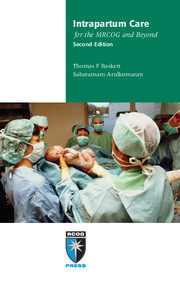Book contents
- Frontmatter
- Contents
- Preface
- Abbreviations
- 1 Improving intrapartum care
- 2 First stage of labour
- 3 Second stage of labour
- 4 Fetal surveillance in labour
- 5 Third stage of labour
- 6 Lower genital tract trauma
- 7 Induction of labour
- 8 Preterm labour and prelabour rupture of membranes
- 9 Assisted vaginal delivery
- 10 Shoulder dystocia
- 11 Breech vaginal delivery
- 12 Twin and triplet delivery
- 13 Caesarean section
- 14 Vaginal birth after caesarean section
- 15 Uterine rupture
- 16 Emergency obstetric hysterectomy
- 17 Cord prolapse
- 18 Antepartum haemorrhage
- 19 Postpartum haemorrhage
- 20 Acute uterine inversion
- 21 Amniotic fluid embolism
- 22 Disseminated intravascular coagulation
- 23 Acute tocolysis
- 24 Severe pre-eclampsia and eclampsia
- 25 Neonatal resuscitation
- 26 Perinatal loss: management of late fetal death and stillbirth
- Index
20 - Acute uterine inversion
Published online by Cambridge University Press: 05 July 2014
- Frontmatter
- Contents
- Preface
- Abbreviations
- 1 Improving intrapartum care
- 2 First stage of labour
- 3 Second stage of labour
- 4 Fetal surveillance in labour
- 5 Third stage of labour
- 6 Lower genital tract trauma
- 7 Induction of labour
- 8 Preterm labour and prelabour rupture of membranes
- 9 Assisted vaginal delivery
- 10 Shoulder dystocia
- 11 Breech vaginal delivery
- 12 Twin and triplet delivery
- 13 Caesarean section
- 14 Vaginal birth after caesarean section
- 15 Uterine rupture
- 16 Emergency obstetric hysterectomy
- 17 Cord prolapse
- 18 Antepartum haemorrhage
- 19 Postpartum haemorrhage
- 20 Acute uterine inversion
- 21 Amniotic fluid embolism
- 22 Disseminated intravascular coagulation
- 23 Acute tocolysis
- 24 Severe pre-eclampsia and eclampsia
- 25 Neonatal resuscitation
- 26 Perinatal loss: management of late fetal death and stillbirth
- Index
Summary
The frequency of acute uterine inversion, a rare but life-threatening condition, depends upon the standard of care during the third stage of labour. The incidence therefore varies widely from about 1/2000 to 1/50 000 deliveries.
The degree of inversion may be incomplete, in which the fundus is inverted but does not protrude through the cervix (first degree), or complete, when the inverted fundus passes completely through the cervix and lies either in the vagina (second degree) or completely out side the introitus (third degree) (Figure 20.1).
Causes
The combination of uterine relaxation and fundal insertion of the placenta provides the important predisposition to acute uterine inversion, a predisposition which may then be converted to uterine inversion by the factors discussed below.
• Mismanagement of the third stage of labour is the cause in the majority of cases, either by pressure on the uterine fundus or by premature traction on the umbilical cord before the placenta has separated and when the uterus is relaxed. This provides additional support in favour of active management of the third stage of labour, because the administered oxytocic and ensuing uterine contraction make it impossible to turn the uterus inside out.
• An acute rise in intra-abdominal pressure as a result of maternal coughing or vomiting can rarely produce a strong enough propulsive force on the uterine fundus to cause inversion, if the vulnerable setup of a fundally implanted placenta and uterine relaxation are present.[…]
- Type
- Chapter
- Information
- Intrapartum Care for the MRCOG and Beyond , pp. 225 - 232Publisher: Cambridge University PressPrint publication year: 2011



